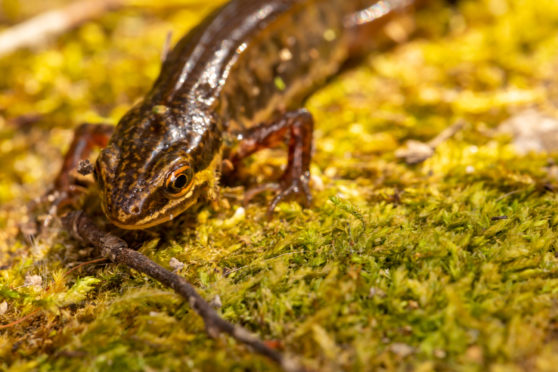Here I am: first with the newts. You will recall perhaps, if you’ve been paying attention, that there’s a pond in my garden.
As with the former swimming pool, I hadn’t paid too much attention to it when buying the house, even though I’d always fancied a pond.
It was the icing on the cake, but I was too focused on the cake. And on the sky. During the viewing, I said to the estate agent: “Such a lovely sky. If it comes with the house, I’ll buy it.”
It was only after I’d bought the house that somebody said: “You’ve got newts, you know.” And I said: “It’s all right. I think Boots have got a cream for that.”
Of course, when I looked in the pond, there was nary a newt to be seen. That’s nature for you. Like the kung fu master, looked for, it cannot be seen; listened for it, it cannot be heard. It’s very irritating.
Soon, I forgot all about the newts, believing them to be a local myth designed to scare me back to the city.
However, one sunny morning recently, I took my morning dawdle to the pond. A friend in the city had contacted me on my portable telephone to talk about football, or its lack.
As I was speaking to him, I leaned on the rickety yellow railing that I’d recently painted (the paint already peeling off again due to the inconsiderate elements), looked into the pond and there it was: a newt. Wriggling.
I shifted my gaze slightly: another one. And another. My mate became discomfited at my silence on his important point regarding the fitness of our favourite footer team’s midfield during their enforced absence.
When I spoke again, it was in a reverential whisper, and he said: “What’s that you’re saying? You’ve gone all David Attenborough. Is it dolphins again?”
He was referring to a previous occasion when he’d phoned and I’d spotted several creatures in the sea. “Not dolphins, mate,” I explained. “Newts. And it wasn’t dolphins before. It was otters.”
I’ll be quite candid with you and confess I know nothing about newts. However, in the interests of research and adding an unusually educational note to this column, I’ve just looked them up on Wikipedia: they’re salamanders in the family Pleurodelinae. Well, glad we cleared that one up. They’re Mrs Peluodelinae’s wee lassies.
It says that not all salamanders are newts, but all newts are salamanders. Funny, that’s what I was thinking. The reason I hadn’t seen them earlier was that they spend most of their time on land and only go into the pond to reproduce. Kind of water birthing, I guess.
There’s some stuff about fertilised eggs, but I don’t think we need dwell on that in a family column like this. Besides, that’s enough reading. I just want to gawp at them, not study them.
My mate was still on the phone. “You done with your newts yet? You’re turning into Gussie Fink-Nottle.” The Fink-Nottle under advisement was a P.G. Wodehouse character obsessed with newts.
“Sorry,” I said. “What were you saying about our midfield?”
At that moment, a voice croaked up from the pond: “Tell him, it’s not your midfield you need to worry about. It’s your forward line.”
Amazing creatures.










